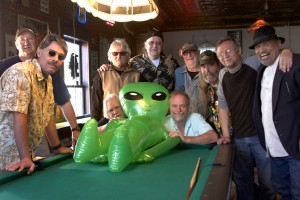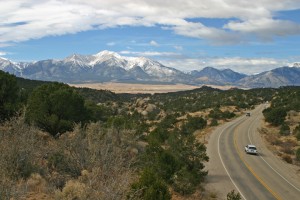by Susan Tweit
Driving across the San Luis Valley recently, Richard and I spotted groups of sandhill cranes probing the stubble of harvested fields for seeds and insects. Standing four feet tall, with wide gray wings, long, skinny legs, and necks outstretched, these birds are unmistakable.
They’re also part of this improbable high-desert-and-marsh landscape. Twice a year, some 20,000 sandhill cranes, essentially the entire population that migrates along the Rocky Mountains, descend on the San Luis Valley on their thousand-or-more-mile long migration between nesting grounds as far north as Alberta and wintering habitat as far south as Mexico.
During the weeks they spend in the windswept oasis of the valley, the tall birds feed intently, replenishing stores of energy depleted by their long journey, call in throaty voices, and dance.
In the midst of a flock of hundreds of cranes feeding in the stubble of a valley field, two cranes face each other: They bow, bending their long legs and inclining their heads; they leap into the air one after the other, they stretch bills upward in unison, and they utter their tremulous and carrying calls.
Prehistoric artifacts and stories passed down over generations indicate that sandhill cranes have been coming to the San Luis Valley for at least as long as people have – 12,000 years or more. I cannot imagine this high-desert landscape without the sound of their voices, the rhythm of pairs dancing and courting, the sight of hundreds of cranes, wings outstretched, long necks leading and legs trailing, spiraling upward in aerial gyres.
The San Luis Valley is home for these sandhill cranes, not in the sense of their place of birth, but of a landscape that calls them to return year after year, a place where their lives flavor the seasons and weave the fabric of the high desert.
My clan of humans has not called any particular place home for many generations. We were pulled from Scandinavia and Scotland to this continent in search of fortune, and then impelled by inner restlessness to move from state to state.
Like sandhill cranes, my brother and I migrated to specific landscapes: he, tied to salmon, lives in the Pacific Northwest where those big fish swim long ocean migrations before following the scent of their natal stream home; I belong to the ocean of silvery and fragrant sagebrush that laps at the shores of the Rocky Mountains.
Home, I think, is not so much a place of birth as an attachment of heart and spirit, a landscape whose call is so insistent that we are impelled to travel epic journeys to reach its comforting contours, and to return, year after year, until death resets our course.
Home is where we give as much as we get, the way flocks of sandhill cranes fertilize the valley soil where they feed and roost, any place where our voices linger in song and story and the memories of our sojourn stir hearts long after we are gone, regardless of whether we were born there or how long we stay.
(Portions adapted from The San Luis Valley: Sand Dunes and Sandhill Cranes, by Susan J. Tweit with photographs by Glenn Oakley)
Award-winning writer Susan J. Tweit is the author of 12 books, and can be contacted through her web site, susanjtweit.com or her blog, susanjtweit.typepad.com/walkingnaturehome

